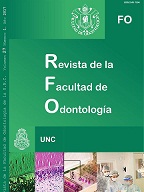Effectiveness of different desinfections/sterilization protocols for heat sensitive orthodontics instruments
Palavras-chave:
orthodontic, dental instruments, disinfection, sterilizationResumo
Objective: The aim of this work was to assess effectiveness of different disinfections/ high level disinfection protocols for heat-sensitive orthodontics instruments. Methods: Eight protocols were applied to orthodontic instruments (n=120); they were cleaned with dual- or triple-enzyme detergent and disinfected with glutaraldehyde 2.5% or hypochlorite 1% or orthophthalaldehyde 0.55%.After applying each protocol, samples were taken from the instruments and cultured in MacConkey Agar and CLED Agar media. For Staphylococcus spp, a coagulase test was used. Instruments were considered contaminated when the CFU count from the cultures was greater than 105 CFU/ml. Results: The same proportion of contamination was found when using glutaraldehyde and sodium hypochlorite, and no significant differences were found with the use of dual-enzyme and triple-enzyme detergents. Of the three disinfectants used, orthophthalaldehyde was significantly more efficient, since contamination was never found when it was used. The microorganisms isolated from the different instruments were Micrococcusspp, Corynebacterium spp, Bacillus sppandcoagulase-negative Staphylococcus. Conclusions: Orthophthalaldehyde was significantly more efficient as a disinfectant. The microorganisms isolated were Micrococcus spp, Corynebacterium spp, Bacillus spp and coagulase-negative Staphylococcus. Although the percentage of contaminated instruments was low in relation to the total monitored, any contaminated instrument implies risks to a patient or a professional of an infectious or contagious disease.Downloads
Publicado
2017-03-21
Edição
Seção
INVESTIGACIÓN
Licença
Aquellos autores/as que tengan publicaciones con esta revista, aceptan los términos siguientes:
- Los autores/as conservarán sus derechos de autor y garantizarán a la revista el derecho de primera publicación de su obra, el cuál estará simultáneamente sujeto a la Licencia de reconocimiento de Creative Commons que permite a terceros:
- Compartir — copiar y redistribuir el material en cualquier medio o formato
- La licenciante no puede revocar estas libertades en tanto usted siga los términos de la licencia
- Los autores/as podrán adoptar otros acuerdos de licencia no exclusiva de distribución de la versión de la obra publicada (p. ej.: depositarla en un archivo telemático institucional o publicarla en un volumen monográfico) siempre que se indique la publicación inicial en esta revista.
- Se permite y recomienda a los autores/as difundir su obra a través de Internet (p. ej.: en archivos telemáticos institucionales o en su página web) después del su publicación en la revista, lo cual puede producir intercambios interesantes y aumentar las citas de la obra publicada. (Véase El efecto del acceso abierto).

